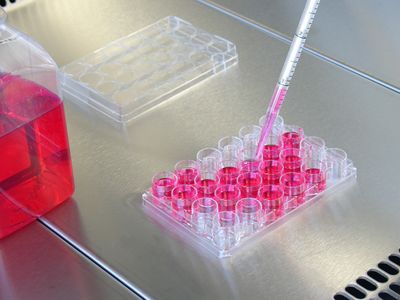
Traditional organ transplants are complicated endeavors. From long wait times to assessing the immunological similarities of patients and potential donors, it can take years until a match is found. According to the Health Resource and Service Administration, seventeen Americans die each day waiting for an organ transplant.1
Scientists are exploring substitutes for transplantation, including the use of human pluripotent stem cells (hPSCs) as alternative therapeutics. hPSCs are precursor cells that have the ability to differentiate into any cell type of the body with the appropriate environmental or culture conditions. In vitro, stem cells taken from patients can generate tissues and organs that have less risk of rejection compared to donor material. As such, increasing their production is necessary to meet demands. Current methods to increase hPSC production rely on generating complicated culture conditions to mimic the cellular environment.2 Therefore, researchers are investigating alternative methods to reduce the level of human input needed to produce copious amounts of stem cells.
“In the ideal world, we would generate functional cells from stem cells by using synthetic gene circuits to increase [stem cell] yields or cell types to eventually be used in cell and gene therapies,” said Peter Zandstra, a research scientist at the University of British Columbia. To make this a reality, Zandstra and his colleagues, including first author Laura Prochazka, strategically designed a synthetic gene circuit to detect and control what differentiated state a cell is in. This work was recently published in Molecular Systems Biology.3
A synthetic gene circuit is an engineered gene network controlled through transcriptional or post-transcriptional regulations to coordinate a desired output. To control hPSC cell-state transitions, Zandstra’s team utilized a post-transcriptional regulatory mechanism through engineered microRNA (miRNA)-based logic circuits. The circuits fine tune gene expression by harnessing miRNAs’ ability to bind and facilitate the degradation of RNA containing miRNA response elements (MREs). In this study, the circuits were designed to detect a cell’s state (hPSC vs non-hPSC) or to modulate the expression of user-specified genes to control the differentiation state.
In the ideal world, we would generate functional cells from stem cells by using synthetic gene circuits to increase [stem cell] yields or cell types to eventually be used in cell and gene therapies.
- Peter Zandstra, University of British Columbia
“Controlling the cell has been an important goal,” said Gábor Balázsi, a synthetic biologist at Stony Brook University in New York, who was not involved in this study. “It’s an interesting way to couple these two efforts [detecting cell state and differentiation], basically removing human input.”
As a proof of concept, the researchers expressed their circuits in hPSCs and confirmed whether they could control cellular differentiation. They used BMP4 expression as the output, which is required to differentiate hPSCs into different cell types. When the researchers modulated BMP4 expression using different MRE variants, called miRNA silencing-mediated-fine-tuners (misFITs), they observed a dose-dependent response in differentiation. For instance, variant cells expressing BMP4 at low levels remained in the undifferentiated pluripotent state. In contrast, cells expressing moderate to high levels of BMP4 formed gastrulation patterns, similar to cells exposed to exogenous BMP4. This indicated that the circuits can coordinate cell-state transitions in a dose-dependent manner.
With a successful proof of concept, Zandstra is excited about what is to come. “I think we’re really at the very beginning of starting to introduce more complex circuits into pluripotent stem cells, and this paper shows is that it’s possible,” he said. Moving forward, the researchers want to engineer these complex circuits to kill unwanted differentiated cells or track cell states to monitor hPSC production to for applications in regenerative and transplantation medicine.
References
- "Organ Donation Statistics," https://www.organdonor.gov/learn/organ-donation-statistics, accessed Feb 19, 2023.
- S. Dakhore et al., "Human pluripotent stem cell culture: current status, challenges, and advancement," Stem Cells Int, 2018:7396905, 2018.
- L. Prochazka et al., "Synthetic gene circuits for cell state detection and protein tuning in human pluripotent stem cells," Mol Syst Biol, 18(11):e10886, 2022.




